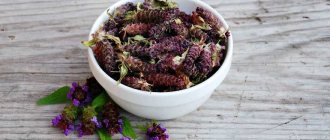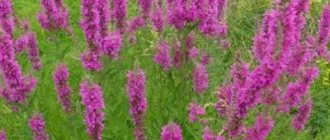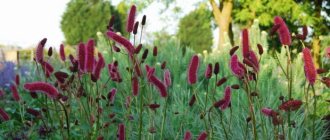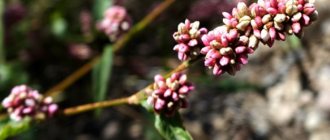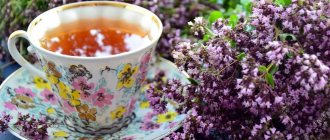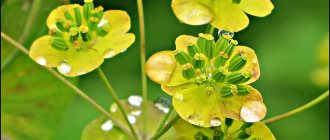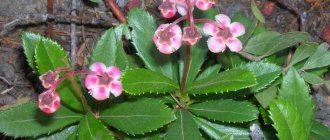Description of the plant
Periwinkle is a perennial evergreen subshrub.
It can grow up to 35 cm in height. The roots are thin, up to 70 cm long. The plant stems are of two types: creeping and vertical. The first type is non-fruit-bearing, stretches one and a half meters and takes root. Vertical stems grow up to 20 cm. The leaves are short-petioled and remain throughout the winter. They are oblong-elliptical in shape, 3-5 cm long. Dark green on top, slightly lighter below, gray-green, shiny. The leaves are collected in whorls of 3 pieces. The flowers come in dark blue and dark blue colors, their diameter is 2-3 cm. They are located one at a time on the stalks. The fruit of the plant is two curved leaflets up to 8 cm with brown seeds. Periwinkle blooms in May-June. Fruit ripening begins in June.
This plant attracted the attention of people in ancient times and was considered a medicinal product due to the fact that it was credited with magical powers. But already in the 18th century they learned to use it as a sedative and antihypertensive drug. Although doctors at that time actively used periwinkle, the medicinal properties and contraindications were not yet fully studied.
What kind of plant is this?
Periwinkle is a perennial subshrub that, like the Christmas tree, never changes its color from green. The plant is gifted with a thin rhizome located horizontally and creeping stems. Bright blue single flowers captivate the eyes of all passersby.
The flowering period begins in April and lasts until September. Fruits almost never appear. The plant is known by many names. Some know it as imperial grass, greengrass or hornbeam, but to most it is nothing more than periwinkle.
Periwinkle is native to Europe and the Middle East. The plant can be found in Belarus, Moldova, Russia, and also in Ukraine. Most often, periwinkle can be found in bushes, oak or hornbeam forests. It has a beautiful appearance and is also easy to care for. These two qualities make periwinkle a popular ornamental plant. Quite often it can be found in various bouquets or flower arrangements.
As for Russia, only 5 species of periwinkle grow on its territory, although not all of them are used in medicine. Only two are endowed with medicinal value - the small periwinkle and the pink one. Because of its beneficial properties, periwinkle is very often used in traditional and folk medicine. It is also used in homeopathy.
Due to the high content of alkaloids, the leaves and stems of periwinkle are used in the manufacture of various potent medicinal products.
As the legend goes, the periwinkle visited the goddess Flora with a complaint that people had stopped paying attention to it, although it blooms earlier than all other plants. Flora took pity on the periwinkle and rewarded it with large and beautiful flowers. She also gave him the name of his firstborn and long life.
Where does it grow
This plant loves steppe slopes, edges of deciduous forests, clearings and places between bushes. Periwinkle is widespread in the European part of Russia, Ukraine, Crimea, Moldova, Belarus, the Baltic states, the Caucasus, and also in Asia Minor. Spreads by roots, dividing the bush and by seed. The plant is unpretentious in care and tolerates shade well. Today, periwinkle is often planted as an ornamental plant in flower beds, parks or cemeteries. In the cold winter it may freeze, but in the summer it will definitely recover. Although many have seen periwinkle blooming in forests or ravines, the beneficial properties and chemical composition of this plant are not known to many people.
Preparation and storage
The plant is harvested during the flowering period, in late spring, early summer. It is at this time that periwinkle contains the greatest amount of healthy substances. The above-ground part of the plant is cut with a knife at a height of 3-5 centimeters from the surface of the ground.
In one place, harvesting can be carried out no more than once every three years. You cannot pull out the plant along with the roots, as this will lead to the disappearance of periwinkle in the area.
The raw materials are dried under a canopy outdoors or in rooms with good ventilation, spread in a thin layer. You can also dry raw materials in special dryers at a temperature of no more than 50 degrees Celsius. Under the right conditions, the raw materials dry out within a week.
The herb is stored in dry rooms with good ventilation. The shelf life is two years. After this, the plant begins to quickly lose its beneficial properties. The plant is poisonous, so it is recommended to use respirators and gloves when assembling and harvesting. Store periwinkle separately from other herbs.
Plant composition
In past times, this shrub was used only for certain diseases. Years later, additional research was conducted to find out what areas of health periwinkle can affect. Medicinal properties and contraindications depend on the chemical composition. The herb contains more than 20 alkaloids, among them there are those that have an oncolytic effect, these are minorin, devincan, isomaidine, reserpine, ajmalicine, pubescin, vinine and others. The composition contains malic, acetic, ascorbic, and succinic acids. It also contains rutin, carotene, flavonoids, mineral salts, pectin, triterpene saponins, glycosides, phytosteropes and tannins.
Growing Lesser Periwinkle
Growing a plant is not a tricky business, as it is known for its amazing adaptability and survival in any conditions. It likes to grow on sandy loam soils, among stones and embankments. Small periwinkle grows well in sunny and shaded places, grows quickly and is unpretentious.
Basic care
- Plant care is usual: watering, weeding, fertilizing with mineral fertilizers.
- It is better to plant the flower in rock gardens or at the front edge of a flower bed.
- It looks great in flowerpots, flowerpots, plant pots and along garden paths.
Reproduction
The plant propagates in two ways: using root shoots and cuttings. You can do cuttings all summer long; to do this, you need to cut off several vertical shoots and place them in moist soil. Do this right in the garden bed; the cuttings take root well, and if you water them on time, root shoots will appear within a week. All that remains is to plant the seedlings in the right place.
Medicinal properties
Considering the rich chemical composition that periwinkle has, its medicinal properties and contraindications lie in the following areas. The plant can be used as:
- wound healing;
- hemostatic (improves the contractile function of the uterine muscles);
- hypotensive (dilates blood vessels and reduces vascular tone, thereby reducing blood pressure);
- sedative (the alkaloid vincamine affects the nervous system, calming it);
- blood purifying;
- astringent (the plant has an inhibitory effect on pathogenic flora);
- laxative (increases relaxation of the muscle tissue of the small intestine;
- restorative (improves metabolic processes).
It is worth noting that pink periwinkle is rich in alkaloids, which have an antitumor effect; they have a destructive effect on cancer cells.
Uses in traditional medicine
Alkaloids, found in the herbaceous part and flowers of the small and pink periwinkle, are the active ingredients of some common drugs:
- Vincamine, vinpocetine - normalize blood circulation in the brain.
- Devinkan – improves blood supply to the brain.
- Vinkapan - relieves spasms of cerebral vessels, accordingly, eliminates the main cause of migraines.
- Devinkan, Cavinton - also improve blood supply to brain tissue and normalize blood pressure. Prescribed for hypertension and neurogenic tachycardia.
- Vincristine - prescribed for acute leukemia, especially in children.
- Vinblastine, vinorelbine - are used to slow down the development of benign and malignant tumor cells.
- Rosevin - used to treat chorioepithelioma, multiple myeloma, and lymphogranulomatosis.
Use in folk medicine
Traditional healers often use periwinkle in their recipes. The medicinal properties and contraindications of this plant allow it to be used for various ailments. Thus, it has a beneficial effect on migraines, dizziness, fever, scurvy, toothache, bad breath, enteritis, stomach pain, diarrhea and colic. Periwinkle is also useful for bronchitis, tuberculosis and colds. It can be taken by people who develop hypertension. The plant is often used for women's leucorrhoea and sexual weakness in men.
Periwinkle is used externally if bleeding occurs from the nose, uterus, lungs or hemorrhoids. If inflammation has formed in the oral cavity or toothache has occurred, rinses are prescribed. Lotions help if a rash, itchy skin, weeping eczema or wounds occur.
Periwinkle
Botanical description
Herbaceous evergreen subshrub with stems rooting at the nodes up to 40-60 cm long, mostly creeping. Periwinkle thickets can form an evergreen carpet up to 10-15 cm high. The flower stalks, which bear large blue or violet-blue flowers above the foliage during the flowering period, are located more vertically. Leaves are leathery. Mass flowering occurs in May. Grows in oak and beech forests in the Carpathians, forest-steppe regions of Right Bank (less often Left Bank) Ukraine, in Central and Southern Europe.
Lesser periwinkle keeps its leaves green in winter - symbolizing eternal love. There was a belief that if a young man and a girl, tearing a periwinkle leaf in half, each ate their other half, then love would not cool down and they would never part!.. But why only one leaf, and not two or three? But because periwinkle is far from harmless, and in large doses it is poisonous! Be careful! Otherwise, the true love of two loving hearts can develop into an eternal memory - it’s not for nothing that periwinkle often weaves between gravestones in old cemeteries.
Joy and grief are all relative in the sublunary world, and these two sides of love often walk side by side in life.
Since ancient times, people have believed in the miraculous and healing power of periwinkle. It was even believed that periwinkle had the power to destroy malignant tumors. And yet, in folk medicine, periwinkle leaves collected during flowering were used primarily as a tonic, hypotensive, astringent and wound-healing agent.
Healing effect and application
Vinca herb has been used in folk medicine to treat bleeding gums, sore throat, hypertension, impotence, bronchitis, bad breath, enteritis, colitis (by mouth), scurvy and toothache (gargling).
In official medicine, the plant is used only for hypertension, tachycardia, brain spasms and neuroses, since the main effect of periwinkle is hypotensive and vasodilating (especially for cerebral vessels). Vinca preparations containing alkaloids (for example, vincamine, reserpine, isovincamine) are used not only to dilate the blood vessels of the brain and heart, but also to stimulate uterine contractions, relax the intestinal muscles, providing to varying degrees hemostatic, anti-inflammatory, antimicrobial and hypotensive effect.
Use in homeopathy
An infusion (in a water bath or in a thermos) is prepared based on the calculation of 10 g of dry raw materials per 200 ml of boiling water, drink 1 tablespoon 3 times a day. For hypertension, it is more common to use a decoction of periwinkle leaves: 1 tablespoon of crushed leaves is boiled in a glass of boiling water for 20-30 minutes (or 40-50 minutes in a water bath), then taken 1-2 teaspoons 4-5 times a day.
Externally, the same decoction is used for rinsing for inflammation of the oral mucosa, as compresses or lotions for eczema, itchy skin, other skin diseases, skin rashes, and bleeding gums.
How to cook a plant
You can independently collect and prepare small periwinkle for further treatment. Medicinal properties and traditional medicine recipes have been collected over the years. Below are some tips for making homemade periwinkle medicine:
- Hypertension. Boil a spoonful of crushed leaves in 200 ml of water for 20 minutes. Take the strained broth 4 times a day, ¼ cup.
- Colds, intestinal disorders, fever as a hemostatic, wounds, rashes and mouth rinse. Chopped shoots and leaves 2 tbsp. Place spoons in 300 ml of boiling water. Boil for another 15 minutes, then wait another hour for the product to infuse. Take 100 ml three times a day. Compresses and rinses are made from this decoction.
- With a decrease in sexual tone. A tincture is prepared with vodka or alcohol (250 ml). 20 g of flowers and herbs are dipped into alcohol. Bring to a boil and set aside to cool. Take 8 drops in the morning and at night for 4 days. This is followed by a two-day break. Repeat this pattern only three times.
- Dermatitis. Place a spoonful of herbs in a thermos and pour boiling water over it. Moisten the cooled, strained infusion into gauze and wrap the affected areas.
- Headache, nosebleeds, cough, eczema and skin rash. Prepare a tincture with alcohol and take it.
- Allergic diathesis. Ten fresh leaves need to be ground and mixed with a spoon of melted butter. Heat the mixture and leave to infuse for 20 minutes. Rub the strained mixture onto problem areas of the skin.
- Internal bleeding. Suitable for itchy dermatitis and washing wounds. Dip the herbs and flowers (30 g) into boiling water and steam with the lid closed for 10 minutes. Strain the now cooled broth. Drink half a glass three times a day.
- Headache. Infuse 20 grams of the plant (leaves) in 100 ml of alcohol. The drug is ready for use on the 10th day. Take five drops three times a day before meals. If the disorders are caused by a narrowing of blood vessels in the brain, in this case it would not be amiss to plant such a useful plant as periwinkle in your area.
Medicinal and beneficial properties
As noted above, thanks to the unique rich chemical composition of periwinkle, which is represented by a huge range of components useful for human life, the plant is successfully used for the treatment and prevention of various ailments.
- Among its healing qualities, traditional healers note the following positive properties:
- expands, strengthens blood vessels, makes them stronger and more elastic;
- strengthens the immune system, allows you to fight viruses and infections faster and more effectively;
- normalizes brain function;
- improves male potency;
- has a beneficial effect on the heart muscle.
Find out also what jasmine is good and bad for human health.
Decoctions and tinctures from the leaves and stems of the plant are recommended for use for problems such as:
- toothache;
- nose bleed;
- infertility;
- headaches and migraines;
- high blood pressure and tachycardia;
- psychoses;
- skin diseases;
- scurvy and gum problems;
- ulcers of the stomach and duodenum;
- stomatitis and gingivitis;
- rheumatism;
- diarrhea.
Pharmacological drugs made on the basis of periwinkle are prescribed:
- to normalize blood circulation in the brain;
- for acute leukemia;
- for children with mental retardation;
- with female menopause;
- to eliminate dizziness, migraines and headaches;
- with neurogenic tachycardia;
- as an antitumor agent;
- with vegetative-vascular dystonia.
If the product is used in the correct dosages and according to a certain scheme, then it has a beneficial effect on the entire human body, on its internal and external state.
Medicinal properties and contraindications: reviews from people
Today, not everyone knows that Vinca minor can be used in herbal medicine, but those who have already tried it on themselves testify to its beneficial effects.
Some women prepare a decoction to make it easier to survive menopause. Also, during sexual dysfunction, some men support themselves with medicine from periwinkle leaves. To support their immune system or normalize the nervous system, patients prepare a decoction, infusion or alcohol tincture. The effect will be noticeable in any preparation.
Many people use periwinkle to get rid of migraines. But it is worth noting that the medicine prepared on the basis of this plant is not a panacea for headaches, since much may depend on the causes of the painful condition. As you can see, many actively use periwinkle in folk medicine. The medicinal properties of the plant have been experimentally proven, but despite this, it is important to use this herb carefully.
How to prepare and store
Correct preparation of raw materials, as well as further storage of the drugs, are considered to be a guarantee of the high effectiveness of drugs based on periwinkle. The plant is recommended to be collected in spring or at the beginning of the summer season. The crop is carefully cut with a sharp, disinfected knife at a level of 4–6 cm from the soil surface. Next, the raw materials are dried for one week, having first spread them out in a thin, even layer on a mesh, a piece of gauze or other breathable natural material. Well-dried grass is placed in paper bags or cotton bags and sent to a warm place, reliably protected from dampness and direct rays of the sun.
Video: Collection, preparation and storage of periwinkle
Infusions
Periwinkle infusions have the shortest shelf life. them immediately after preparation, within one day, since the processes that lead to fermentation and, as a consequence, the formation of bacteria, quickly change the composition of the product, turning it from healthy to hazardous to health . The ideal option is to prepare a new, fresh portion of the medicine each time.
Decoctions from leaves
Herbal decoctions also need to be consumed fresh, as they quickly lose their properties.
But since these products undergo heat treatment, they can be stored in the refrigerator and consumed:
- for cosmetic purposes for wiping or compresses for 1–3 days;
- for domestic consumption - no more than 1 day.
Important! Freezing medicinal decoctions or infusions is unacceptable.
If the product becomes cloudy, films form on the surface, or an unpleasant aroma appears, using such a decoction is strictly prohibited.
Alcohol tinctures
Unlike infusions and decoctions, periwinkle tinctures made with alcohol can be stored for several months.
The main thing when preserving the product is to comply with some important conditions:
- dark, dry, well-ventilated place;
- protection of the drug from direct sunlight;
- packaging tightness.
Under such conditions, alcohol tinctures can retain their beneficial qualities for six months. If the product has acquired an unpleasant odor or changed color, then it is unacceptable to use it.
Periwinkle is one of the best medicinal plants, which is successfully used in folk medicine, cosmetology, and pharmaceutical production. The culture has a wide range of effects and, with proper, dosed consumption according to instructions, can cure many ailments. However, you need to remember that this herb is poisonous, so its use should be agreed with a doctor.
Cautions
Periwinkle is allowed to be used only after talking with your family doctor. This indication is especially true if the medicine is taken orally. Periwinkle is a poisonous plant, any overdose is unacceptable, as it can suppress the functioning of the heart, in some cases such treatment can lead to cardiac arrest. Do not use for treatment of bradycardia, lactation and pregnancy.
Contraindications and application features
It is important to remember that periwinkle is a poisonous plant, and exceeding the norms for using products based on it can cause side effects:
- dizziness;
- nausea and vomiting;
- weakness.
In addition, this plant has a number of contraindications for use:
- age up to 14 years;
- individual immunity;
- pregnancy and breastfeeding;
- low blood pressure;
- tendency to allergies.
Before starting to use plant-based products, you should consult a herbalist or your doctor.
Health to you!
Contraindications
In order for the treatment to be beneficial, you need to take into account the medicinal and beneficial properties of Vinca minor and the contraindications that it has. The plant is poisonous . When taken internally, it is necessary to strictly adhere to the recommended dosages. In case of an overdose, depression of cardiac activity, slowing of the pulse, dizziness, loss of consciousness, and difficulty breathing may occur.
Lesser periwinkle is contraindicated for:
- bradycardia,
- brain tumors,
- pregnancy.
Benefits of periwinkle
Periwinkle is a useful plant. Since ancient times, people have been using it in various areas of their lives.
Pharmacology uses Vinca minor as a medicinal raw material. All parts of the plant are used in production: rhizomes, leaves, flowers and stems. Of particular value are the alkaloids that are extracted from periwinkle extract.
The positive effect of the alkaloid vincamine on the blood vessels of the brain has been scientifically proven. It restores the intensity of blood flow and normalizes metabolism. Thanks to these positive changes:
- increased concentration and performance;
- memory improves;
- Constant headaches disappear.
Improving cerebral circulation helps prevent ischemia and atherosclerosis. A person taking medications based on vincamine calms down the nervous system, and the feeling of constant stress and emotional overstrain disappears. All this happens without side effects such as feelings of lethargy and drowsiness.
Benefits of periwinkle, medicinal properties
A group of medicines based on chemical substances isolated from periwinkle has proven itself well in the pharmacological market. These are the well-known and popular drugs Vinpocetine, Cavinton, Oxibral, Vincapan, Vinebral.
The alkaloid Devincan is included in the drug for the treatment of hypertension of the first and second degrees. Having identified the substance’s ability to reduce vascular tone, thereby dilating the blood vessels of the brain, pharmacologists developed a drug of the same name.
The alkaloids vinblastine, vincristine, vinorelbine are cytostatics. Their ability to destroy cell growth processes in the body is used to combat malignant cells. By killing their ability to reproduce, drugs in this group prevent the growth of cancer in the human body.
Use of periwinkle in medicine
In addition to unique alkaloids, periwinkle contains organic acids, essential oils, minerals, and tannic acids. Preparations based on periwinkle are used in many branches of medicine. Among them are dentistry, endocrinology,
gynecology, urology, gastroenterology. Considering that research into the beneficial properties of periwinkle continues, the scope of its use in medicine is expanding.
Use in cosmetology
The periwinkle plant is used in cosmetology. The protective properties of the plant were known to the ancient Celts; they called this flowering plant witch violet. Vinca extract is an anti-inflammatory, antiseptic and astringent substance. Rubbing the skin with periwinkle tincture improves oxygen saturation of cells and accelerates wound healing. Flower extract is added to ointments and oils used to treat acne, dermatitis and eczema.
